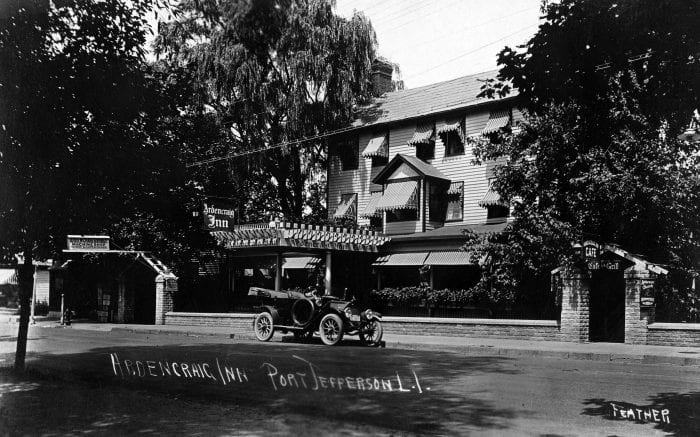By Kenneth Brady
Port Jefferson’s rich and varied history is reflected in the stories of many of the village’s street names.
Alice Street — Winfield Darling (1877-1965) built summer bungalows on what is today Alice Street, named for his daughter Alice.
Arden Place — Middle Street was renamed Arden Place after the Ardencraig Inn, which once stood on the northeast corner of Main Street and Arden Place. The Inn was destroyed in a March 2, 1920 fire.
Barnum Avenue — The celebrated showman P.T. Barnum (1810-1891) purchased land in the “Brick Hill” section of Port Jefferson where he developed the acreage for housing. Today’s Barnum Avenue is the main thoroughfare in the subdivision.
Belle Terre Road — Port Jefferson’s current railroad station opened in July 1903. Belle Terre Road was a route between the new depot and Belle Terre, whose developers had donated the land on which the railroad station was constructed.
Hallett Avenue — Charles Hallett (1833-1894) was a prosperous businessman from Riverhead, and one of P.T. Barnum’s agents in developing the “Brick Hill” section of Port Jefferson. Today’s Hallett Avenue, formerly Summit Street, is one of the arteries in Barnum’s subdivision.
Hawkins Street — Originally Mittyville Street, Hawkins Street takes its name from Zachariah F. Hawkins. He was appointed Port Jefferson’s first postmaster when the village was called Drowned Meadow.
Hoyt Lane — Harry V. Hoyt (1879-1969) developed “Hoyt Heights” on the west side of Port Jefferson Harbor. Today’s Hoyt Lane is one of the roads in the subdivision.
Liberty Avenue — During World War I, some defense plant workers at Bayles Shipyard were housed along Cemetery Avenue. Saddled with negative connotations, Cemetery Avenue was changed in 1918 to an upbeat Liberty Avenue, a name which reflected the patriotic fervor of the times.
Linden Place — Shipbuilder C. Lloyd Bayles (1811-1903) planted linden trees behind his house on the south side of today’s Linden Place.
Mill Creek Road — A flour mill once stood on the south side of West Broadway beside the creek that empties into Port Jefferson Harbor. Signs along the Old Mill Creek Walkway highlight the history of the area.
Nadia Court — Countess Nadia de Navarro Farber (1916-2014), a former Bulgarian musical-comedy star, was the wife of Sid Farber (1913-1985), a builder of homes, shopping centers, offices and industrial parks.
Nicholas Street — Nicholas Shelow (1889-1941) was a Port Jefferson merchant who developed today’s Nicholas Street.
Oakes Street — Mary Eliza Oakes (1850-1934) married Charles P. Randall (1848-1932), a prominent Port Jefferson businessman. The couple’s home was located on the corner of Oakes Street and Randall Avenue, named after the bride and groom, respectively.
Perry Street — Marvin B. Perry (1919-2001) operated a plumbing supply store on Perry Street, formerly Chestnut Street.
Prospect Street — North Street was renamed Prospect Street because of the “fine prospective view” from William L. Hunt’s 20-acre property which ran between upper North and South streets. The Hunt homestead, later known as the Biddle Mansion, burned to the ground in August 1931.
Quintin Court — Active in community affairs, Quintin A. Lerch (1881-1963) served as Brookhaven Town’s Tax Receiver, president of the board of directors at Mather Memorial Hospital, vice president of the Bank of Northern Brookhaven and treasurer of the local Rotary Club.
Roessner Lane — George N. Roessner (1925-1981) was a beloved business teacher, guidance counselor, football coach, and club advisor at Port Jefferson’s Earl L. Vandermeulen High School.
Rosita Lane — Rosita Winston (1904-1979) was the wife of real estate mogul and philanthropist Norman K. Winston (1899-1977), who developed Port Jefferson’s Harbor Hills Country Club and Harbor Hills Estates.
Sheldrake Avenue — Sea captain Richard W. Sheldrake (1865-1945) once lived on the corner of today’s Sheldrake Avenue and Bayview Terrace.
Texaco Avenue — Texaco Oils formerly operated a gasoline storage facility along the Long Island Rail Road tracks on the west side of Bowers Avenue, today’s Texaco Avenue.
Thompson Street — John Thompson was a blacksmith who was deeded land in Port Jefferson by Brookhaven Town. The property included today’s Thompson Street.
Thorne Lane — LIRR locomotive engineer George R. Thorne (1902-1997) and his family lived for years on today’s Thorne Lane, formerly Tuthill Avenue.
William Street — William Fordham (1826-1907) was a realtor who developed today’s William Street.
Wynn Lane — Albert L. Wynne (1856-1942) was a liveryman. His stables were located on what was once called Private Lane, today’s Wynn [sic] Lane.
Port Jefferson’s street names not only identify locations, but many serve as historical markers by providing a record of the village’s past.
Kenneth Brady has served as the Port Jefferson Village Historian and president of the Port Jefferson Conservancy, as well as on the boards of the Suffolk County Historical Society, Greater Port Jefferson Arts Council and Port Jefferson Historical Society. He is a longtime resident of Port Jefferson.





